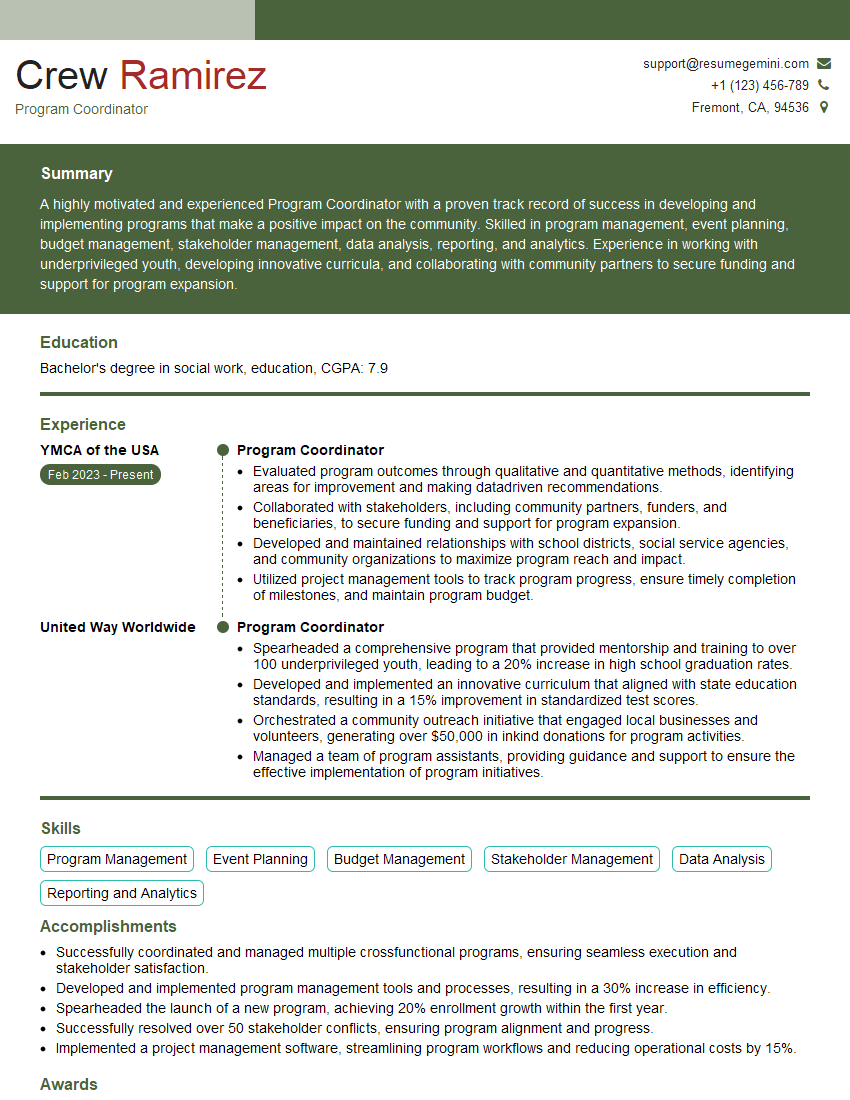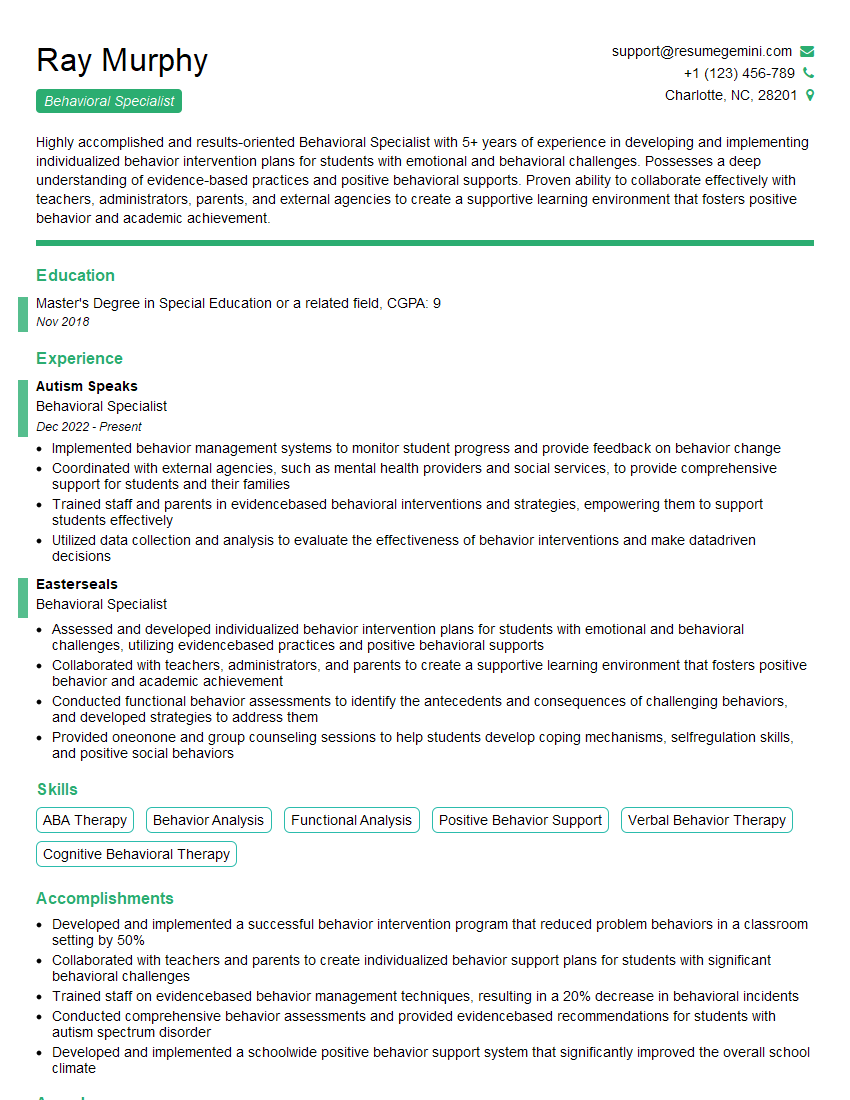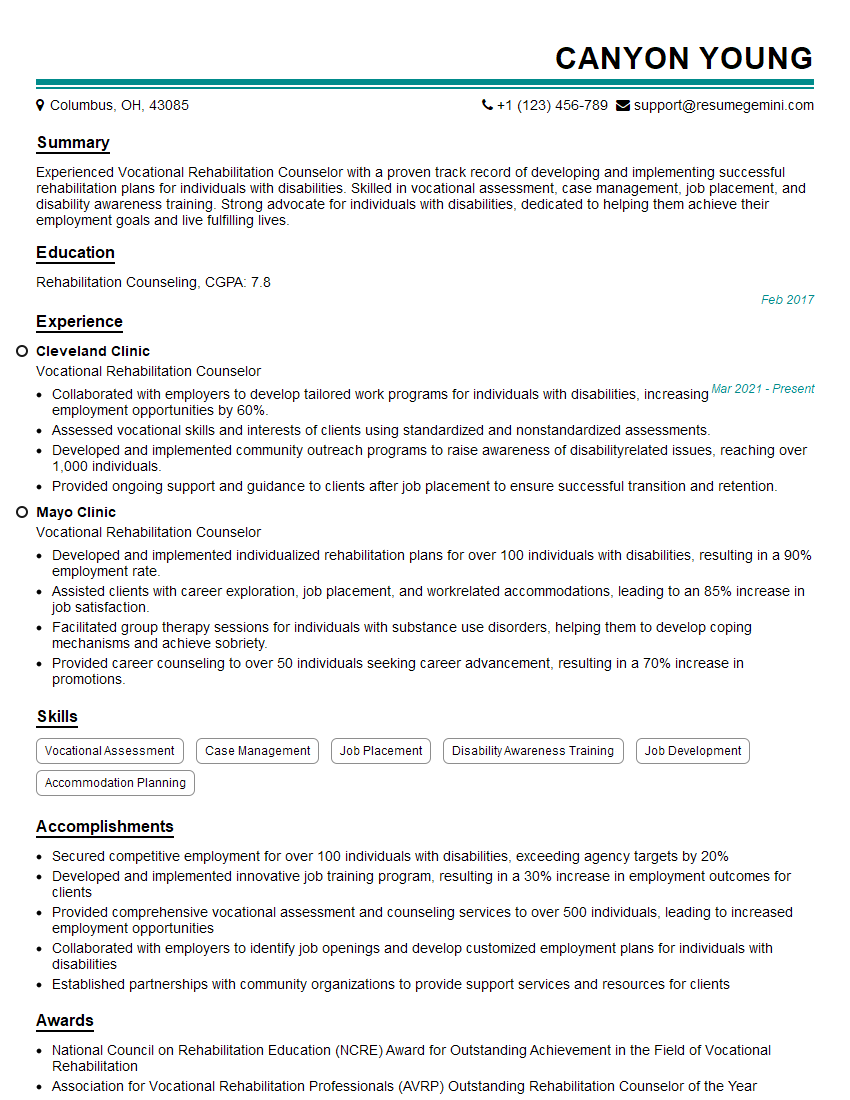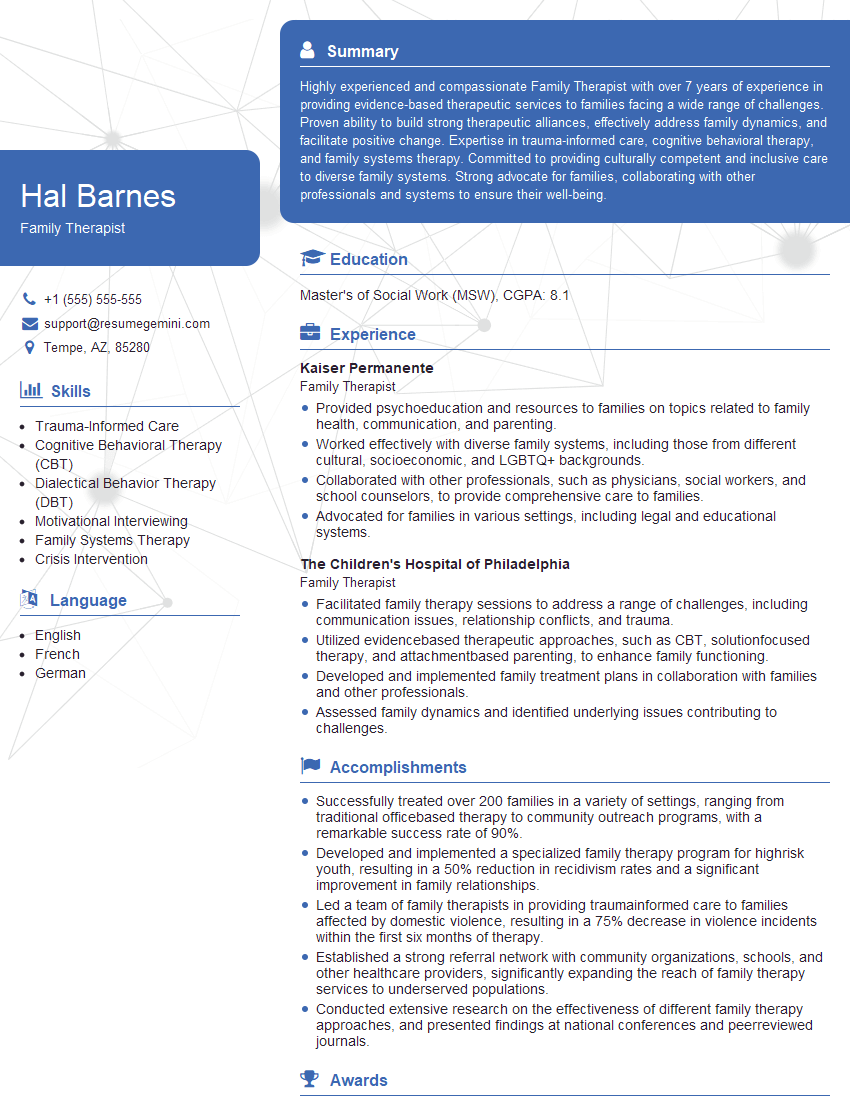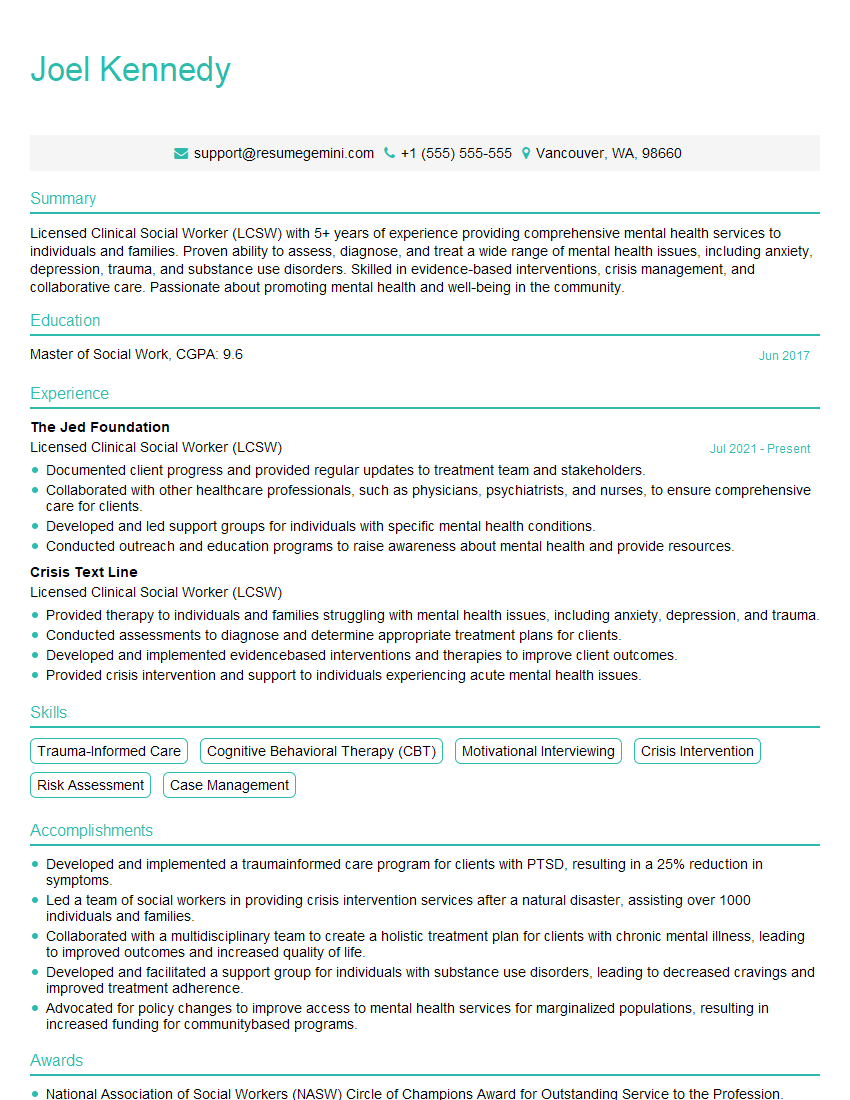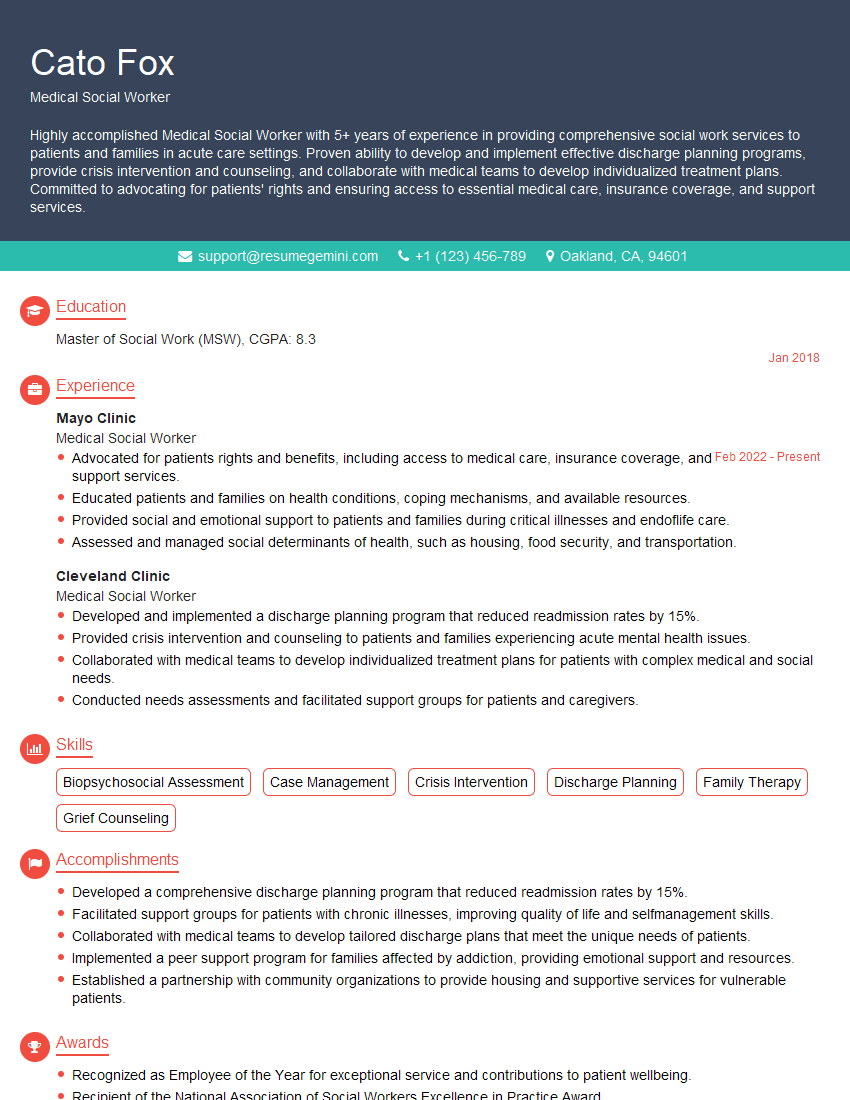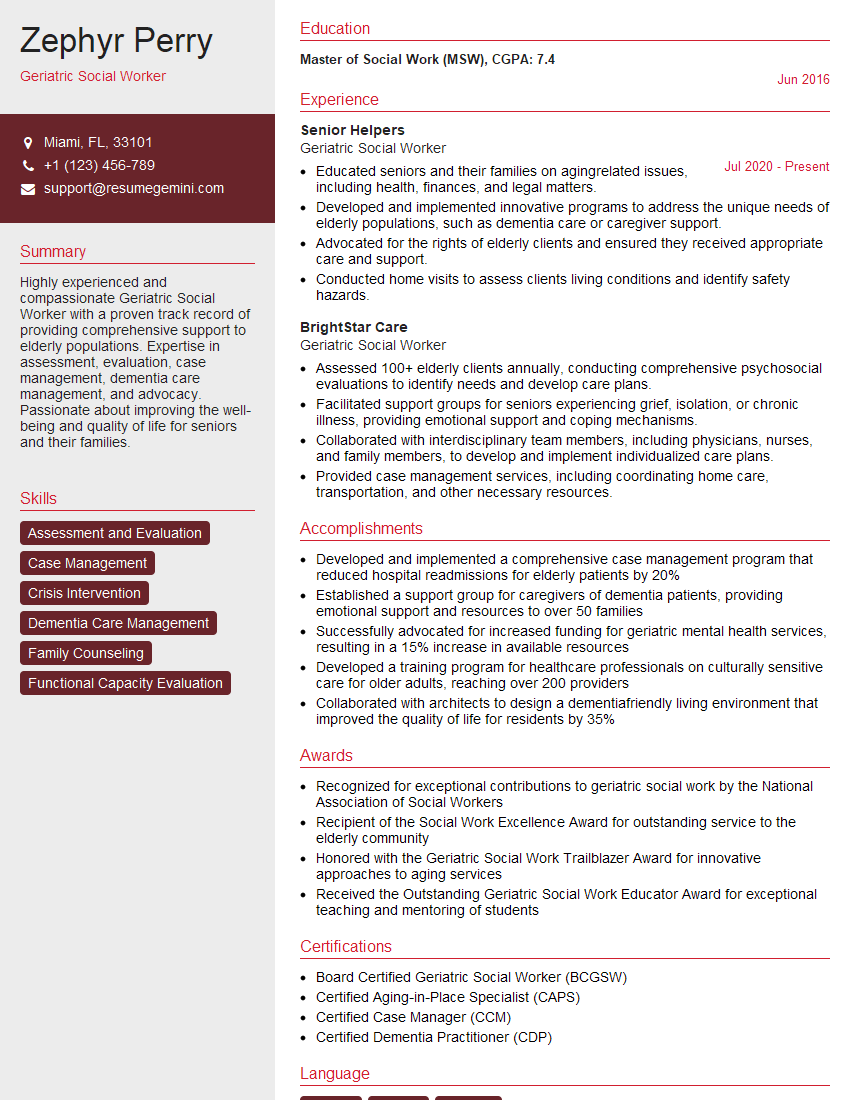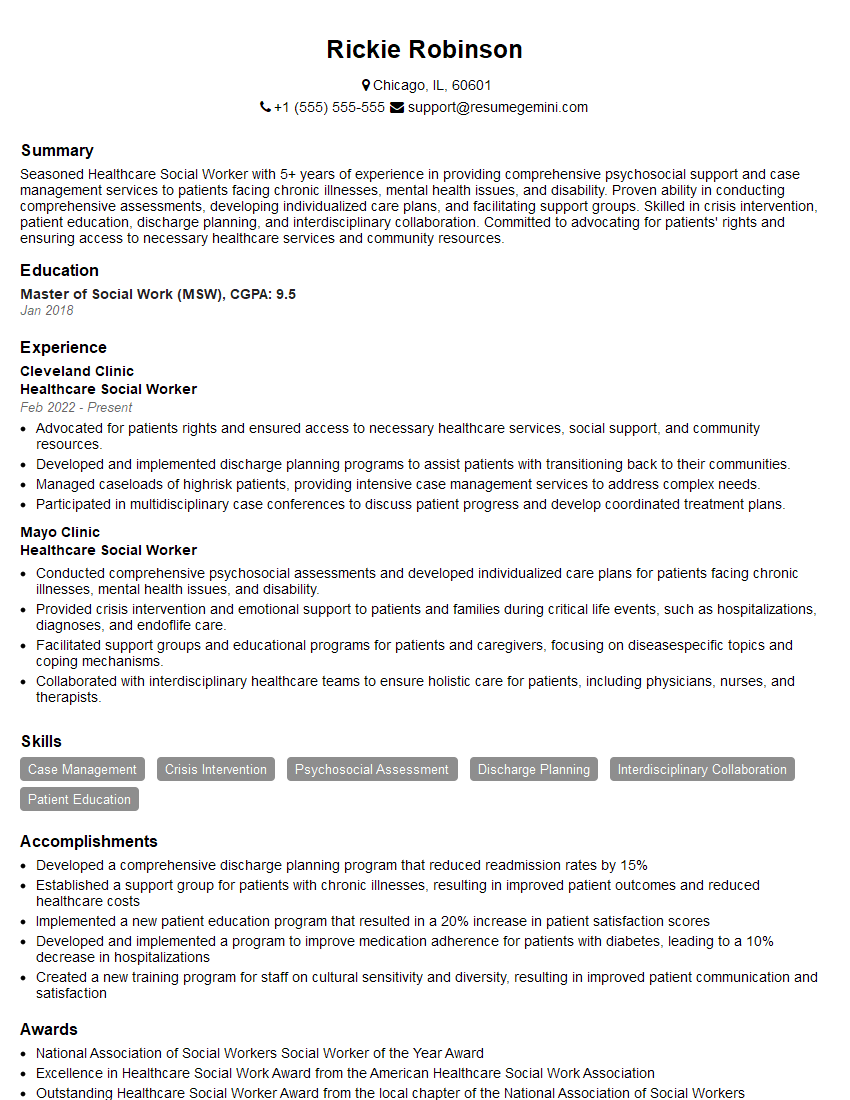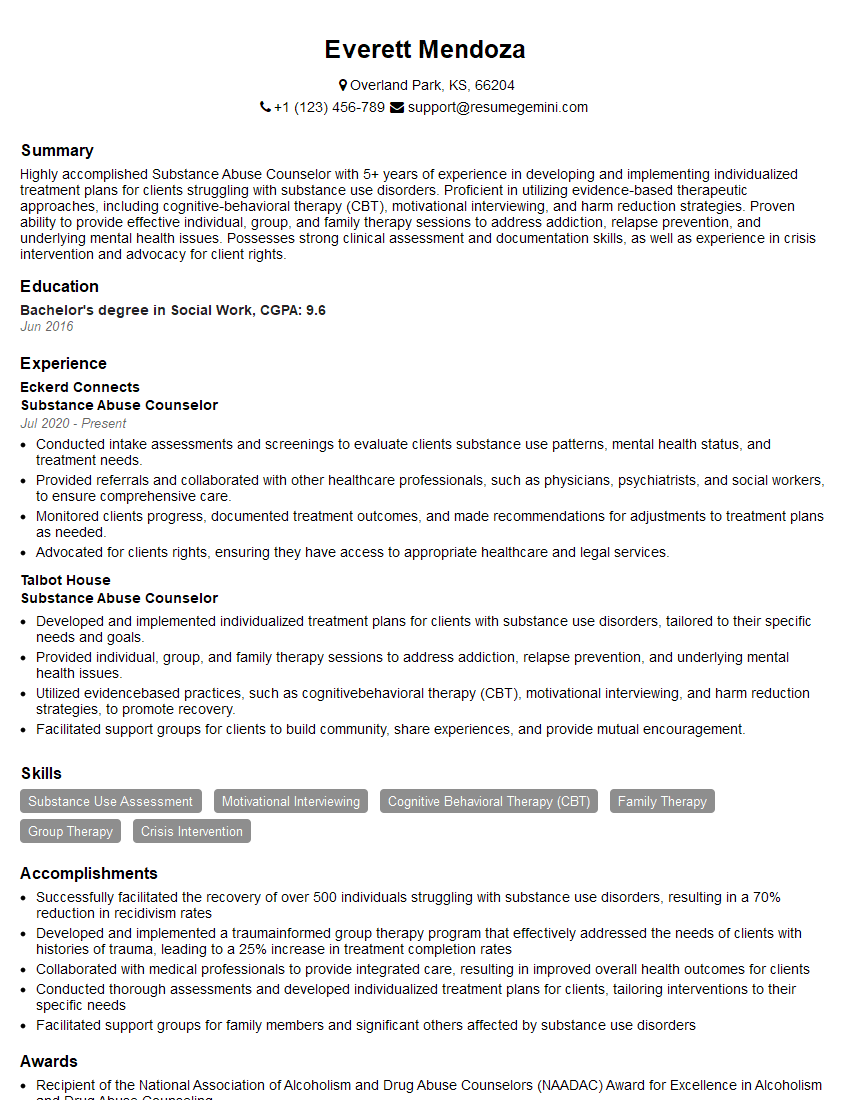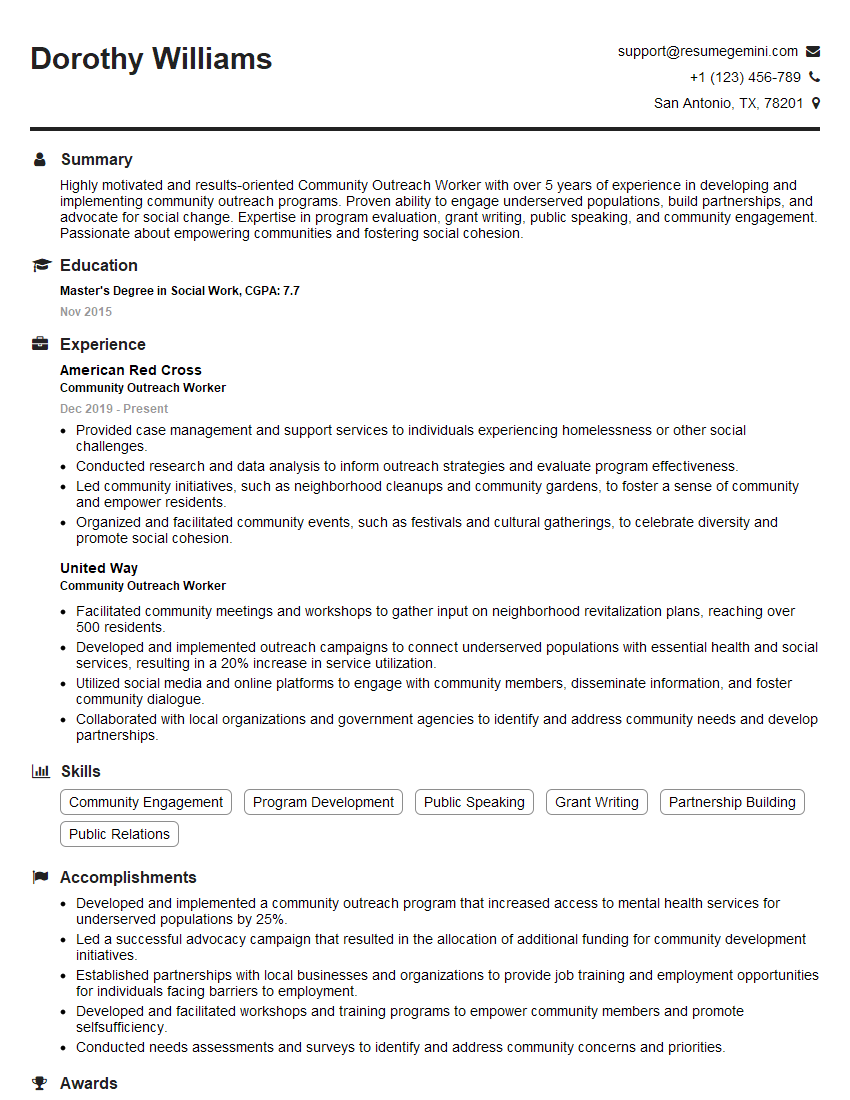The right preparation can turn an interview into an opportunity to showcase your expertise. This guide to Social Services Knowledge interview questions is your ultimate resource, providing key insights and tips to help you ace your responses and stand out as a top candidate.
Questions Asked in Social Services Knowledge Interview
Q 1. Describe your experience with crisis intervention.
Crisis intervention is a short-term, solution-focused approach aimed at stabilizing individuals experiencing acute distress or a mental health crisis. It involves immediate assessment, de-escalation techniques, and connecting individuals with necessary resources. My experience includes working with individuals experiencing suicidal ideation, domestic violence, substance abuse relapse, and acute psychotic episodes. I’ve employed techniques like active listening, validation, and collaborative problem-solving to help individuals regain control and develop safety plans. For instance, I once worked with a young woman experiencing a severe panic attack. Using calm and reassuring language, I helped her identify triggers, practice deep breathing exercises, and connect her with her support network, preventing a potentially harmful escalation.
A key element is rapidly assessing the level of risk and ensuring immediate safety. This might involve contacting emergency services, providing temporary shelter, or arranging for psychiatric evaluation. Post-crisis intervention is also crucial, focusing on developing long-term coping strategies and connecting clients with ongoing support services.
Q 2. Explain your understanding of the ethical considerations in social work.
Ethical considerations in social work are paramount, guiding practice to ensure client well-being and uphold professional integrity. Core values include confidentiality (with exceptions mandated by law, such as child abuse), autonomy (respecting client self-determination), beneficence (acting in the client’s best interest), non-maleficence (avoiding harm), and justice (promoting fairness and equity). Navigating ethical dilemmas often involves careful consideration of competing values and potential conflicts of interest.
For example, a client might disclose illegal activities, creating a conflict between confidentiality and legal obligations. In such cases, careful consideration of the relevant laws and ethical guidelines is necessary, often involving consultation with supervisors or legal counsel. Maintaining professional boundaries, avoiding dual relationships (e.g., becoming friends with a client), and ensuring informed consent are also crucial ethical considerations. I always prioritize transparency and client self-determination in my practice, empowering clients to make informed choices about their care.
Q 3. How do you prioritize competing demands in a caseload?
Prioritizing competing demands in a caseload requires a systematic approach. I utilize a combination of urgency, risk assessment, and client needs. A framework I employ involves:
- Risk assessment: Identifying clients facing imminent danger (e.g., suicidal thoughts, imminent eviction) takes priority.
- Urgency: Addressing issues with immediate consequences, such as court appearances or medical appointments, are prioritized.
- Client needs: Assessing the relative severity and impact of various needs helps determine the order of intervention. Collaboration with the client is key to determine their priorities.
- Time management: Effective time management techniques, such as scheduling, prioritization matrices (like Eisenhower Matrix), and delegation (where appropriate) are crucial.
For example, if I have a client facing eviction and another struggling with depression, I would prioritize the immediate housing crisis while incorporating the mental health concerns into the overall treatment plan. Regular case reviews and reassessment of priorities ensure my efforts remain focused and effective.
Q 4. Describe your experience with client advocacy.
Client advocacy involves acting on behalf of clients to ensure their rights and needs are met. This includes navigating complex systems, such as healthcare, housing, and legal services. My experience encompasses advocating for clients with disabilities to access appropriate services, assisting individuals experiencing homelessness in securing housing, and representing clients in court proceedings. I’ve successfully helped clients obtain benefits, resolve disputes with landlords, and access necessary medical care.
A recent example involved a client with a disability who was facing discrimination in their workplace. I worked with them to gather evidence, draft a formal complaint, and connect them with legal resources to protect their rights. Advocacy involves not only direct action but also educating clients about their rights and empowering them to advocate for themselves.
Q 5. How do you build rapport with clients from diverse backgrounds?
Building rapport with clients from diverse backgrounds requires cultural humility and sensitivity. It starts with self-reflection on one’s own biases and assumptions. I actively listen to understand each client’s unique experiences, perspectives, and cultural values. I avoid making assumptions and instead ask open-ended questions to gather information. I am mindful of verbal and non-verbal communication styles and adapt my approach to suit individual needs. This includes being aware of potential language barriers and utilizing interpreters when necessary.
For example, when working with a client from a different cultural background, I would take the time to learn about their culture and beliefs. I would avoid using jargon or language that they may not understand, and I would be sensitive to their communication style and preferences. Building trust is essential and requires patience, empathy, and respect for cultural differences. Showing genuine interest in their lives and acknowledging their lived experiences forms the bedrock of strong therapeutic alliances.
Q 6. Explain your understanding of the DSM-5 (or equivalent diagnostic manual).
The DSM-5 (Diagnostic and Statistical Manual of Mental Disorders, 5th Edition) is the standard classification of mental disorders used by mental health professionals. It provides a comprehensive framework for diagnosing and understanding various mental illnesses, including their symptoms, prevalence, and course. It’s crucial for accurate diagnosis, guiding treatment planning, and facilitating communication among healthcare providers. Understanding the DSM-5 also allows for more accurate research and data collection on mental health conditions.
The DSM-5 employs a categorical diagnostic approach, classifying disorders based on specific symptom criteria. It’s important to note that the DSM-5 is a tool, and diagnoses should always be made within a broader clinical context considering the individual’s history, cultural background, and overall functioning. Over-reliance on the DSM-5 can lead to diagnostic overshadowing, meaning other important factors might be overlooked. I use it as a guide but prioritize a holistic assessment of the individual.
Q 7. Describe your experience with developing and implementing treatment plans.
Developing and implementing treatment plans involves a collaborative process with the client. It begins with a thorough assessment to understand the client’s needs, goals, strengths, and challenges. The plan outlines specific, measurable, achievable, relevant, and time-bound (SMART) goals. For example, a treatment plan for depression might include goals such as improved mood, increased social engagement, and reduced suicidal ideation. These goals are broken down into smaller, manageable steps.
The plan details interventions, such as therapy sessions (type and frequency), medication management (if applicable), and other resources (e.g., support groups, community services). Regular monitoring and evaluation are integral; I track progress, make adjustments as needed, and involve the client in evaluating the plan’s effectiveness. It’s a dynamic process, adapting to the client’s evolving needs and circumstances. Good documentation is essential for continuity of care and accountability. I always ensure the client is actively involved in the process, empowering them to take ownership of their treatment.
Q 8. How do you assess client needs and strengths?
Assessing client needs and strengths is a crucial first step in providing effective social services. It involves a holistic approach, considering the individual’s physical, emotional, social, and environmental factors. I utilize a combination of methods to achieve a comprehensive understanding.
- Structured Interviews: I conduct in-depth interviews using open-ended questions to understand the client’s situation, concerns, and goals. This allows for a free-flowing conversation and reveals valuable insights beyond simple yes/no answers.
- Observations: Observing client interactions and behaviors during sessions can reveal important information about their communication style, coping mechanisms, and overall functioning.
- Standardized Assessments: Depending on the client’s needs, I might utilize standardized tools like depression scales or functional assessments to gain objective data about their abilities and challenges. This provides a baseline for measuring progress.
- Collateral Information: I often gather information from other sources like family members, medical professionals, or previous service providers with the client’s consent. This helps to create a more complete picture and avoids bias.
- Strengths-Based Approach: Throughout the assessment, I actively focus on identifying the client’s strengths, resilience, and resources. This positive framing empowers them and helps create a collaborative plan.
For example, when working with a client struggling with unemployment, I wouldn’t just focus on their job loss; I’d explore their previous work experience, skills, educational background, and support networks to highlight their strengths and identify potential avenues for re-employment.
Q 9. Explain your understanding of the stages of grief and loss.
The stages of grief and loss, as described by Kübler-Ross, are a helpful framework, although it’s important to remember that individuals experience grief uniquely and don’t always progress linearly through these stages. The stages are:
- Denial: A refusal to accept the loss or its implications.
- Anger: Feeling frustrated, resentful, and even hostile towards oneself, others, or a higher power.
- Bargaining: Attempting to negotiate with fate or a higher power to undo or change the loss.
- Depression: Feeling overwhelming sadness, hopelessness, and despair.
- Acceptance: Coming to terms with the loss and finding a way to move forward.
It’s crucial to understand that these stages aren’t necessarily sequential or experienced in this exact order. Some individuals may skip stages, while others may revisit them. My approach focuses on validating the client’s emotional experience, providing empathy and support, and helping them develop healthy coping strategies to navigate their grief at their own pace.
For instance, I might work with a client experiencing the death of a loved one by providing a safe space for them to express their emotions, exploring healthy coping strategies such as journaling or spending time with supportive family members and, if needed, connecting them with grief support groups.
Q 10. How do you manage challenging client behaviors?
Managing challenging client behaviors requires a calm, empathetic, and proactive approach grounded in safety and de-escalation techniques. My strategy involves several key steps:
- Understanding the Root Cause: I try to understand the underlying reasons for the behavior. Is it related to trauma, mental health issues, substance abuse, or unmet needs?
- Setting Clear Boundaries: Establishing clear and consistent boundaries is vital for both the client’s and my own safety. This includes outlining acceptable and unacceptable behaviors.
- De-escalation Techniques: I use active listening, validating the client’s feelings, and remaining calm to de-escalate tense situations. Physical interventions are only used as a last resort and only when absolutely necessary for safety.
- Collaborating with the Team: If the behavior is severe or poses a risk, I collaborate closely with supervisors, clinicians, or law enforcement as needed.
- Safety Planning: Developing a safety plan with the client, which outlines steps to take when feelings escalate and potentially dangerous situations arise, is an important preventative measure.
For example, if a client becomes verbally aggressive, I would remain calm, validate their feelings (e.g., “I understand you’re feeling angry right now”), and attempt to redirect the conversation towards their underlying concerns. If the situation doesn’t de-escalate, I would implement the safety plan, which might involve taking a break and regrouping.
Q 11. Describe your experience with working with families.
My experience working with families has been extensive and rewarding. I understand that family dynamics are complex and significantly impact individual well-being. I frequently employ a family systems perspective, recognizing that changes in one family member affect the entire system.
- Family Meetings: I often facilitate family meetings to improve communication, identify strengths and challenges, and collaboratively develop solutions.
- Parent Training: I provide parents with tools and strategies to effectively manage challenging behaviors in children, promote positive parenting practices, and strengthen the parent-child relationship. This might include skills training in areas such as behavior modification or effective discipline techniques.
- Sibling Support: Recognizing the impact of a family member’s struggles on siblings, I provide support and interventions to address their emotional and behavioral needs.
- Advocacy: I advocate for families’ access to resources and support services, navigating complex systems to help them access needed assistance.
For instance, I worked with a family where a child was struggling in school. Through family meetings, we identified that parental conflict was impacting the child’s ability to focus. We implemented strategies to improve communication and conflict resolution within the family, and the child’s academic performance improved significantly.
Q 12. How do you maintain client confidentiality?
Maintaining client confidentiality is paramount. I adhere strictly to ethical guidelines and legal regulations regarding the protection of private information. This includes:
- HIPAA Compliance: I follow all HIPAA regulations related to the storage, access, and transmission of Protected Health Information (PHI).
- Secure Record Keeping: I use secure electronic health records and physical file storage systems to protect client information from unauthorized access.
- Limited Information Sharing: I only share client information with authorized individuals or agencies involved in their care, and only with the client’s informed consent, unless mandated by law.
- Informed Consent: Before engaging in any service, I obtain the client’s informed consent, explaining how their information will be used and protected.
- Professional Boundaries: I maintain strict professional boundaries to prevent any breaches of confidentiality.
For example, I would never discuss a client’s case with anyone outside the involved professional team without their express permission, and even then, I only share information that is strictly relevant and necessary.
Q 13. Explain your understanding of trauma-informed care.
Trauma-informed care recognizes the profound and pervasive impact of trauma on individuals and families. It’s an approach that shifts the focus from what’s wrong with a person to what happened to them. Key principles include:
- Safety: Creating a safe and supportive environment where clients feel secure and respected.
- Trustworthiness and Transparency: Building trust and maintaining transparency in all interactions.
- Choice, Collaboration, and Empowerment: Giving clients choices, collaborating with them in decision-making, and empowering them to take control of their lives.
- Peer Support: Utilizing peer support workers who have lived experience with trauma to provide empathy and understanding.
- Cultural, Historical, and Gender Issues: Recognizing the impact of cultural, historical, and gender-based factors on trauma experiences.
In practice, this means avoiding triggering language or behaviors, being mindful of power dynamics, and providing clients with a sense of control over their care. For example, when working with a client who has experienced domestic violence, I would prioritize creating a safe and supportive environment, validate their experiences, and avoid any actions that might re-traumatize them.
Q 14. How do you collaborate with other professionals in a multidisciplinary team?
Collaboration within a multidisciplinary team is essential for effective service delivery. I believe in open communication, mutual respect, and a shared understanding of goals. My approach includes:
- Regular Meetings: Participating actively in regular team meetings to discuss client progress, challenges, and treatment plans.
- Case Conferencing: Attending case conferences to share information, coordinate services, and develop integrated care plans.
- Information Sharing: Utilizing secure methods to share relevant client information with other professionals involved in their care, ensuring confidentiality is maintained.
- Joint Assessments: Conducting joint assessments when necessary to obtain a comprehensive understanding of the client’s needs.
- Respectful Communication: Maintaining respectful communication with all team members, valuing their expertise and perspectives.
For instance, when working with a client with substance use disorder, I’d collaborate closely with their psychiatrist, therapist, and case manager to ensure a coordinated approach to treatment. This might involve regular communication, joint assessments, and the development of a comprehensive treatment plan tailored to the client’s specific needs.
Q 15. Describe your experience with documenting client progress.
Accurate and thorough documentation of client progress is crucial in social services. It’s not just about recording facts; it’s about painting a comprehensive picture of the client’s journey, enabling effective service planning, monitoring, and evaluation. My approach involves using a structured format, typically incorporating SOAP notes (Subjective, Objective, Assessment, Plan), or a similar framework tailored to the agency’s requirements.
For example, in working with a client struggling with substance abuse, the ‘Subjective’ section might include their self-reported feelings and experiences. The ‘Objective’ section would contain observable behaviors and measurable data, like attendance at meetings or negative drug tests. The ‘Assessment’ section would be my professional analysis, interpreting the subjective and objective data to form a holistic understanding. Finally, the ‘Plan’ section details the strategies we’ll implement moving forward, including therapy sessions, support groups, or medication management. I always ensure the documentation is clear, concise, objective, and adheres to confidentiality regulations.
Beyond SOAP notes, I frequently incorporate progress reports that summarize significant milestones, challenges encountered, and overall progress towards stated goals. This ensures a clear narrative for stakeholders such as supervisors, case managers, and other relevant professionals involved in the client’s care. Regular review and updates are crucial to adapt the care plan to the client’s evolving needs.
Career Expert Tips:
- Ace those interviews! Prepare effectively by reviewing the Top 50 Most Common Interview Questions on ResumeGemini.
- Navigate your job search with confidence! Explore a wide range of Career Tips on ResumeGemini. Learn about common challenges and recommendations to overcome them.
- Craft the perfect resume! Master the Art of Resume Writing with ResumeGemini’s guide. Showcase your unique qualifications and achievements effectively.
- Don’t miss out on holiday savings! Build your dream resume with ResumeGemini’s ATS optimized templates.
Q 16. How do you identify and address ethical dilemmas?
Ethical dilemmas are inevitable in social work. My approach to addressing them centers around a structured ethical decision-making framework. I begin by identifying the ethical issue, considering all relevant values and principles (e.g., client autonomy, beneficence, non-maleficence, justice). I then gather relevant information, including legal and agency policies, seeking consultation with supervisors or ethics committees when necessary.
For example, if a client reveals intentions to harm themselves or others, I have an ethical obligation to ensure their safety and the safety of others. This might involve breaking confidentiality (with appropriate legal and ethical justifications) and contacting authorities. This action requires careful consideration of the potential consequences, both positive and negative, and involves balancing the client’s right to self-determination with the responsibility to protect others. This is a delicate balance, necessitating thorough documentation of the decision-making process and steps taken.
Ultimately, my goal is to arrive at a decision that is ethically sound, legally defensible, and in the best interest of the client and the wider community. Continuous professional development and reflection are crucial to maintaining high ethical standards.
Q 17. Explain your experience with crisis management and de-escalation.
Crisis management and de-escalation are critical skills in social work. My experience includes working with clients experiencing intense emotional distress, suicidal ideation, or aggressive behavior. My approach prioritizes safety – both the client’s and my own – while employing techniques to de-escalate the situation and restore calm.
I utilize active listening, empathetic communication, and validation techniques to understand the client’s perspective and address their underlying needs. I avoid judgmental language and maintain a calm, reassuring demeanor. If the situation warrants, I utilize physical distancing if necessary and work within the context of agency protocols and collaborate with law enforcement or emergency services if the situation requires a greater level of intervention.
For example, during an incident with an agitated client, I employed techniques like reflective listening to show that I understood their feelings. By acknowledging their emotions and reframing their experience, I helped reduce their frustration and move toward a more cooperative interaction. Following the crisis, I ensured appropriate follow-up care, including connecting them with mental health services for ongoing support.
Q 18. Describe your understanding of different therapeutic approaches.
My understanding of therapeutic approaches encompasses a range of models, each with its unique strengths and applications. I’m familiar with cognitive behavioral therapy (CBT), which focuses on identifying and changing negative thought patterns and behaviors. I also have experience with solution-focused brief therapy, which emphasizes collaboration and goal-oriented interventions. Person-centered therapy, with its emphasis on empathy and unconditional positive regard, is another approach that I incorporate into my practice.
In practice, I often integrate elements of different approaches to tailor interventions to the individual needs of each client. For instance, with a client experiencing anxiety, I might use CBT techniques to help them identify and challenge anxious thoughts while simultaneously using person-centered techniques to foster a supportive and therapeutic relationship.
Furthermore, my understanding of trauma-informed care is central to my practice, recognizing that many of the issues clients face are rooted in past trauma. This approach informs my work with clients to provide a safe, supportive environment that avoids retraumatization.
Q 19. How do you ensure cultural competency in your practice?
Cultural competency is paramount in social work. It’s about recognizing that each individual brings a unique cultural background that shapes their worldview, values, and beliefs. My approach involves actively seeking to understand the cultural context of each client, including their ethnicity, religion, socioeconomic status, gender identity, sexual orientation, and other relevant factors.
I achieve this through continuous learning, attending workshops and trainings, and actively seeking out resources and mentorship from colleagues with diverse backgrounds. I actively engage in self-reflection to identify my own biases and assumptions, striving for cultural humility and recognizing the limits of my own understanding.
For example, when working with a client from a different cultural background, I might adapt my communication style to be more respectful of their cultural norms and preferences. I would also involve their family or community leaders in the care plan where appropriate and culturally accepted.
Understanding different communication styles and family dynamics is critical for successful intervention. The goal is to establish trust and rapport by demonstrating respect for their cultural values and traditions.
Q 20. Explain your experience with utilizing community resources.
Utilizing community resources is essential for providing comprehensive and effective social services. My experience involves building and maintaining strong relationships with various organizations and agencies that can offer support to clients. This includes healthcare providers, mental health services, housing agencies, employment programs, and legal aid organizations.
I regularly assess client needs to identify appropriate resources and assist them with navigating the application process, providing advocacy and support throughout. This might involve making referrals, arranging transportation, or accompanying clients to appointments. I maintain updated directories of local resources and regularly review their services to ensure they align with client needs.
For example, I assisted a client facing homelessness by connecting them with a local shelter, helping them complete the application, and advocating on their behalf to expedite the process. I also referred them to a job training program to help them secure sustainable employment.
Effective resource utilization involves ongoing communication and coordination with other professionals, ensuring seamless and integrated care for the client.
Q 21. Describe your understanding of the legal framework for child protection.
My understanding of the legal framework for child protection is grounded in a thorough knowledge of relevant legislation and regulations. This includes laws related to mandated reporting, child abuse investigation, and court proceedings involving child custody and welfare. I’m familiar with the procedures for reporting suspected child abuse or neglect and the legal requirements related to confidentiality and the sharing of information with authorities.
The process typically involves making a report to the appropriate child protection agency, providing detailed information about the suspected abuse, and following up on the investigation. I understand the importance of documenting all interactions and actions related to child protection cases and adhering to strict guidelines regarding client confidentiality. Understanding the legal requirements for working with children ensures that interventions are both safe and effective.
I also have experience with collaborating with legal professionals and court systems, working to protect the rights and well-being of children involved in the judicial process. This includes preparing reports, providing testimony, and working to ensure the child’s voice is heard and their best interests are considered in all legal proceedings.
Q 22. How do you manage your own stress and burnout?
Managing stress and burnout in social work is paramount, as the work can be emotionally demanding. My approach is multifaceted and focuses on preventative measures as much as reactive ones.
- Self-Care: I prioritize regular exercise, mindfulness practices like meditation or yoga, and ensure I get adequate sleep. These are fundamental to maintaining emotional resilience. Think of it like regularly servicing a car – neglecting it leads to breakdowns.
- Boundary Setting: I’m meticulous about setting professional boundaries. This includes limiting my work hours, avoiding taking work home unnecessarily, and consciously disconnecting after work. I learned early on that blurring the lines between personal and professional life is a fast track to burnout.
- Seeking Support: I actively participate in peer supervision groups where we can discuss challenging cases and share coping strategies. It’s invaluable to have a network of colleagues who understand the unique pressures of the job. We’re all in this together.
- Professional Development: Continuously updating my skills and knowledge helps me feel confident and capable, reducing feelings of inadequacy that can contribute to stress. Learning new techniques and approaches keeps the work engaging and prevents stagnation.
- Seeking Help When Needed: I recognize the importance of seeking professional help if I’m struggling. This is not a sign of weakness, but a demonstration of self-awareness and a commitment to my well-being. It’s okay to ask for help.
Q 23. Explain your experience with caseload management.
Effective caseload management is crucial for providing quality services. My approach involves a structured system that balances efficiency with client-centered care.
- Prioritization: I utilize a system of prioritizing cases based on urgency and client needs. Cases requiring immediate intervention (e.g., risk of harm) take precedence. This ensures that the most vulnerable clients receive timely support.
- Time Management: I use time-blocking techniques to allocate specific time slots for different tasks, including client meetings, administrative duties, and case reviews. This helps me maintain a manageable workload and prevents tasks from piling up.
- Regular Case Reviews: I conduct regular reviews of each case, tracking progress, identifying challenges, and adapting interventions as needed. This ensures that services remain relevant and effective. For example, if a client’s progress plateaus, I might re-assess their goals or refer them to another specialist.
- Documentation: Thorough and accurate documentation is vital for continuity of care and accountability. I maintain detailed records of all client interactions, assessments, interventions, and outcomes.
- Technology: I utilize case management software to streamline processes, such as scheduling appointments, tracking progress notes, and generating reports. This frees up time for direct client work.
For example, in my previous role, I managed a caseload of 30 clients, successfully navigating complex cases involving child protection, domestic violence, and mental health issues. Through careful planning and prioritization, I ensured that all clients received the appropriate level of support.
Q 24. Describe your understanding of the principles of social justice.
Social justice, at its core, is about ensuring equitable access to resources and opportunities for all members of society, regardless of their background or circumstances. It challenges systemic inequalities and strives for a fair and just society.
- Equity vs. Equality: Understanding the difference is crucial. Equality means treating everyone the same, while equity means providing individuals with what they need to achieve equal outcomes. For instance, providing everyone with the same-sized desk is equality, but providing a shorter desk for a smaller child is equity.
- Challenging Oppression: Social justice involves actively challenging systems and structures that perpetuate oppression and discrimination based on factors like race, gender, sexual orientation, class, and disability. This might involve advocating for policy changes or challenging discriminatory practices within organizations.
- Empowerment: It centers around empowering marginalized communities and fostering their self-determination. This includes supporting community-led initiatives and promoting participatory decision-making.
- Advocacy: Social workers play a vital role in advocating for policy changes that promote social justice. This could involve lobbying for legislation, working with community organizations, or raising awareness about social issues.
In my work, I strive to embody these principles by advocating for my clients’ rights, challenging discriminatory practices, and working towards systemic change. This includes collaborating with other agencies and organizations to build a more just and equitable system.
Q 25. How do you evaluate the effectiveness of interventions?
Evaluating the effectiveness of interventions is a critical aspect of social work practice. My approach uses a mix of qualitative and quantitative methods to gain a comprehensive understanding of outcomes.
- Goal Setting: Clear, measurable, achievable, relevant, and time-bound (SMART) goals are established at the outset of intervention. This provides a framework for tracking progress and evaluating success.
- Data Collection: Data is collected throughout the intervention process using various methods, including client self-reports, observations, and feedback from other professionals involved. Quantitative data (e.g., scores on standardized assessments) and qualitative data (e.g., client narratives) are both valuable.
- Progress Monitoring: Regular progress monitoring sessions with the client are scheduled to track progress towards goals. This allows for early identification of challenges and adjustments to the intervention plan as needed.
- Outcome Measures: Once the intervention is complete, outcome measures are used to evaluate its effectiveness. These might include changes in client behavior, improvements in well-being, or reductions in risk factors.
- Case Reviews: Regular case reviews with supervisors or colleagues allow for critical reflection on the effectiveness of interventions and opportunities for improvement.
For instance, in a case involving a client struggling with substance abuse, I might use a combination of self-report questionnaires, urine tests, and behavioral observations to track their progress. Regular meetings and ongoing feedback allow for flexibility and improvements in treatment approaches.
Q 26. Describe your experience with utilizing data to inform practice.
Data plays a vital role in informing social work practice, enabling evidence-based decision-making and improving service delivery. My experience includes utilizing various data sources to guide my practice.
- Program Evaluation: I’ve used data from program evaluations to assess the effectiveness of different interventions and services. This helps to identify what works best and what needs improvement.
- Needs Assessments: I’ve participated in community needs assessments to identify gaps in services and resources. This data informs advocacy efforts and helps to prioritize areas for intervention.
- Client Outcomes: I utilize client outcome data to track progress and evaluate the effectiveness of my interventions. This data is used to modify treatment plans as necessary.
- Administrative Data: I utilize administrative data, such as waitlist lengths or client demographics, to identify trends and challenges within the agency and to inform resource allocation.
- Data Analysis: I’m proficient in basic data analysis techniques, using software such as SPSS or Excel to interpret data and identify patterns. This allows me to draw meaningful conclusions and make data-driven decisions.
For example, by analyzing client demographic data, I identified a significant need for culturally sensitive services for a specific population, leading to the development of a new program tailored to their needs. This data-driven approach made our services more inclusive and effective.
Q 27. How do you handle situations where clients resist interventions?
Client resistance is a common challenge in social work. Addressing it requires empathy, understanding, and a collaborative approach.
- Build Rapport: A strong therapeutic relationship is foundational. Taking time to understand the client’s perspective and building trust are essential before addressing resistance.
- Active Listening: Carefully listening to the client’s concerns and validating their feelings is crucial. This shows that their perspective is respected and helps them feel heard.
- Explore Reasons for Resistance: It’s important to explore the underlying reasons for the resistance. Is it fear, mistrust, lack of understanding, or something else? Addressing the root cause is key.
- Collaboration and Shared Decision-Making: Involve the client in the decision-making process. This helps them feel a sense of ownership and control over their journey.
- Adjusting Interventions: Sometimes the interventions themselves need to be modified or adapted to better meet the client’s needs and preferences. Being flexible and adaptable is crucial.
- Referral: If resistance persists despite attempts to address it, referring the client to another professional may be necessary.
For example, a client might resist attending group therapy due to social anxiety. By acknowledging their fears, exploring the benefits of group therapy in a collaborative manner, and perhaps offering alternative approaches like individual therapy initially, it’s often possible to address the resistance.
Q 28. Explain your understanding of the role of technology in social work.
Technology is rapidly transforming the social work landscape, offering both opportunities and challenges.
- Enhanced Communication: Secure messaging platforms, video conferencing, and telehealth improve access to services, especially for clients in remote areas or with mobility issues. It also allows for more frequent and convenient contact, enhancing the therapeutic relationship.
- Data Management: Electronic health records (EHRs) and case management software improve efficiency and accuracy in data collection, storage, and analysis. This streamlines administrative tasks and frees up time for direct client work.
- Improved Access to Information: Online resources and databases provide access to valuable information about resources, evidence-based practices, and support networks.
- Client Engagement: Technology can be used to engage clients in new and innovative ways, through apps, online support groups, and virtual reality therapy.
- Ethical Considerations: However, ethical considerations such as data privacy, security, and digital equity must be carefully addressed.
For example, telehealth allows me to provide services to clients who would otherwise face significant barriers to access. It also offers opportunities to engage clients with tailored resources and information, strengthening our working relationship.
Key Topics to Learn for Social Services Knowledge Interview
- Vulnerable Populations: Understanding the unique needs and challenges faced by diverse populations (e.g., children, the elderly, individuals with disabilities, marginalized communities) and the ethical considerations involved in their support.
- Social Work Theories and Practices: Applying established theoretical frameworks (e.g., systems theory, ecological perspective) to assess and intervene in complex social situations. Practical application includes case management, crisis intervention, and advocacy.
- Legislation and Policy: Familiarity with relevant federal, state, and local laws and regulations impacting social service provision, including understanding their impact on service delivery and client access.
- Ethical Considerations: Recognizing and addressing ethical dilemmas in social work practice, maintaining client confidentiality, and navigating conflicts of interest.
- Assessment and Intervention Strategies: Developing effective plans to address client needs, utilizing appropriate assessment tools, and implementing evidence-based interventions. Practical application includes identifying resources and coordinating care.
- Community Resources and Collaboration: Knowledge of available community services and the ability to collaborate effectively with other professionals (e.g., healthcare providers, educators) to create a holistic support system for clients.
- Data Analysis and Reporting: Understanding the importance of data collection, analysis, and reporting to measure program effectiveness and advocate for improved services. This includes familiarity with relevant metrics and outcome measures.
- Cultural Competency: Demonstrating understanding of cultural diversity and its impact on client needs and service delivery. This includes adapting strategies to respect and incorporate cultural nuances in practice.
Next Steps
Mastering Social Services Knowledge is crucial for career advancement in this field. A strong understanding of these key areas demonstrates your competence and commitment to providing effective and ethical services. To increase your job prospects, creating an ATS-friendly resume is essential. ResumeGemini can help you build a professional resume that highlights your skills and experience effectively. Examples of resumes tailored to Social Services Knowledge are available to guide you through the process.
Explore more articles
Users Rating of Our Blogs
Share Your Experience
We value your feedback! Please rate our content and share your thoughts (optional).
What Readers Say About Our Blog
Hi, I’m Jay, we have a few potential clients that are interested in your services, thought you might be a good fit. I’d love to talk about the details, when do you have time to talk?
Best,
Jay
Founder | CEO
